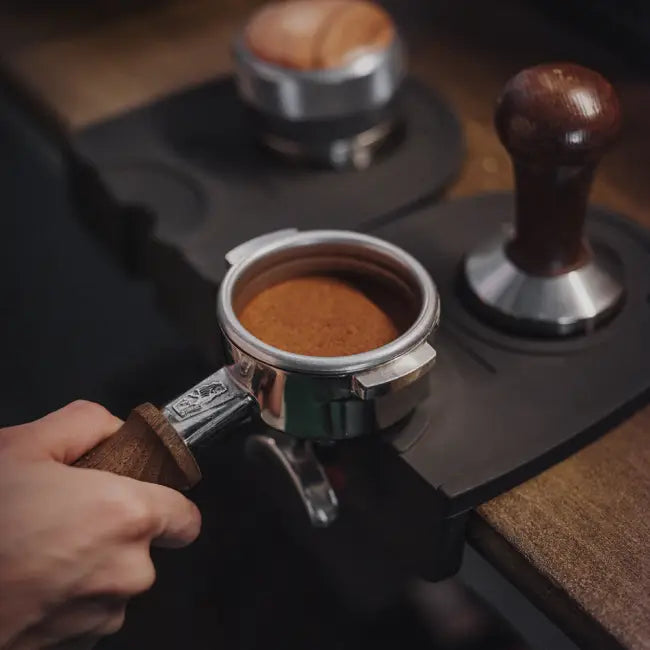Mama Mina Pacamara Peaberry
Get to know this coffee in detail
The Mierisch family is a benchmark in the world of specialty coffee in Nicaragua.
They manage 11 farms with a strong focus on quality, exotic varieties, and competition lots.
The Pacamara variety is a cross between Pacas and Maragogype that has gained popularity for its juicy fruity notes.
This batch also includes Pacamara Peaberry beans, something that used to be considered a defect due to a deformation of the bean (the fruit produces a single seed instead of the two it usually produces) and which is now considered an added value due to the greater density and sweetness that this provides in the cup.
The cherries are pulped and left to ferment for 36 hours in a dry place. They are then washed and left to dry slowly on African beds.
Meet the producer
The Story of Mama Mina of Fincas Mierisch and Her Unique Environment

Mama Mina Coffee Farm, located in the Arenal Nature Reserve in Matagalpa, Nicaragua, is home to unique coffee varieties, such as Pacamara Rojo and Amarillo. Named after great-grandmother Mirna McEwan, this family farm is part of a sustainable farming project that began in 2012. Originally called "La Minita," the name was changed to avoid confusion with a farm of the same name in Costa Rica.

Mama Mina's microclimate offers ideal conditions for growing specialty coffee. Fog covers the land for over 60% of the day, providing natural self-shading. This, combined with cool temperatures, allows for slower ripening of the cherries, a process that directly influences the complexity of the cup profile. Among the varieties grown at Mama Mina are Red Catuai, Javanica, H1, Obata, and the distinguished Red and Yellow Pacamara.
Pacamara Rojo Variety: History and Adaptability

Pacamara Rojo, one of the estate's most iconic varieties, has a fascinating history. Developed in El Salvador in 1958, this variety is a cross between Pacas and Maragogipe. Pacas is a Bourbon mutation discovered by the Pacas family in El Salvador, while Maragogipe is a natural mutation of Typica, discovered in Brazil in 1870. This cross combines the best characteristics of both varieties: the robustness and adaptability of Pacas and the large grains of Maragogipe.
Although it is a delicate plant susceptible to diseases such as rust, Pacamara stands out for its complex cup profile when grown at higher altitudes. Pacamara beans are large, comparable to those of Maragogipe, though slightly smaller. At Mama Mina, only the "elephant" beans are selected through an 18+ sieve, ensuring a selection of visually appealing, high-quality beans.
Peaberry Grains: A Defect That Makes You Fall in Love

This particular batch contains only peaberries, or "caracolillos," carefully selected before export. Peaberries are oval-shaped beans that develop alone within the cherry, rather than the traditional two beans. Although historically considered a "defect" due to their incomplete formation, Mama Mina values their unique flavor and distinctive profile, which can be sold at a premium price due to their rarity.
Harvesting and Fermentation Process
At Mama Mina, the coffee harvesting and drying process is crucial to ensuring quality. It all begins with the collection of cherries at their peak ripeness, followed by a process of flotation in water and pulping with minimal use of this resource. The cherries are then transferred to ceramic fermentation tanks, where they undergo dry fermentation for 36 hours. The tanks are lined with tiles and cleaned regularly to minimize contamination, reducing the risk of defects such as phenol.
Once the mucilage has been removed, the beans are taken to the Don Esteban dry mill for the drying process.
A Unique and Sustainable Drying Method

At Don Esteban, coffee drying is done without conventional concrete patios. Instead, a special method is used: a layer of leftover parchment and a black polymer mesh are placed on the ground to allow air circulation, ensuring even drying. This slow drying follows a conservation philosophy, beginning in direct sunlight for the first two days. The beans are then moved to African beds with 50% shade in a greenhouse, where drying continues for 13 days until a humidity level of 12% or lower is reached, for a total of 15 days of drying.
Once the proper humidity level is reached, the coffee is stored in dry parchment to rest for at least a month, homogenizing the moisture between the beans and extending the coffee's shelf life.
Quality and Sustainability in Every Cup

Mama Mina's detailed cultivation, selection, and drying process ensures that the coffee retains its freshness and quality for longer, protecting the seed embryo and maintaining a rich and balanced cup profile. Every stage of this coffee's production reflects Mama Mina's commitment to quality and sustainability, values that she embodies in every bean, delivering a unique experience to the consumer.






